No. 752: Annual Income, Consumer Liquidity, CPI, Real Retail Sales and Earnings,
COMMENTARY NUMBER 752
Annual Income, Consumer Liquidity, CPI, Real Retail Sales and Earnings,
September 16, 2015
__________
Consumer Conditions Are Deteriorating
2014 Real Median Household Income Fell by 1.5%,
Hitting a Ten-Year Low
2014 U.S. Real Median Household Income
Fell 2.3% (-2.3%) for Native Born, Rose by 4.3% for Foreign Born
2014 Income Variance Measures Held at Historic Extremes
Down in Second-Quarter 2015,
Real Earnings Are on Track for a Flat Third-Quarter
Monthly Real Retail Sales Rose by 0.26% in August, with
Annual Growth Signaling Imminent Recession
August Annual Inflation: 0.2% (CPI-U), -0.3% (CPI-W), 7.8% (ShadowStats)
___________
PLEASE NOTE: The next regular Commentary, tomorrow, Thursday, September 17th, will cover August Housing Starts and the preliminary estimate of the 2015 payroll benchmark revision. The FOMC also will announce any changes in policy from its September meeting.
Best wishes to all! — John Williams
OPENING COMMENTS AND EXECUTIVE SUMMARY
2014 Household Income Measures Signal More Trouble Ahead. These Opening Comments focus on U.S. consumer conditions. First to be covered are the 2014 annual income measures published today (September 16th) by the U.S. Census Bureau (Census) in its 2014 Poverty Report. Second are updated details on the various measures of consumer liquidity and attitudes regularly followed by ShadowStats.
Real Median Household Income Clobbered for Native-Born Americans. Real Median Household Income (inflation-adjusted) dropped by 1.5% in 2014, to a ten-year low, as shown in Graphs 1 and 2. Although the headline change was not statistically significant in aggregate, the changes were statistically-significant, when broken out by certain demographic measures, such as the nativity of the householder. Among those native born, income dropped by a statistically-significant 2.3% (-2.3%), while among the foreign born, income rose by 4.3%. As to all other household characteristics, the only other changes (plus or minus) in median household income determined by Commerce to be statistically significant at the 90% confidence level were a decline of 1.7% (-1.7%) among non-Hispanic Whites, a drop of 4.6% (-4.6%) among households in the West, and a decline of 3.5% (-3.5%) among households inside principal cities.
Graph 1: Annual Real Median U.S. Household Income through 2014

The difference between Graph 1 and Graph 2 is that the red line in Graph 2 reflects the official median household income readings as deflated by the CPI-U-RS, used in the annual Poverty Report. That is a restated version of the headline CPI-U (used in deflating Graph 1). The CPI-U is covered separately, later in this Commentary, for headline August 2015 reporting. The CPI-U-RS (research series) is CPI-U restated by the Bureau of Labor Statistics (BLS) and Census, as though all the inflation-reducing methodologies introduced by the BLS since 1980 were in place as of 1980. The differences have provided significant background and material for the estimation of the ShadowStats Alternate Inflation Measures, which look to recreate the CPI as if none of the inflation-debilitating changes had been made to CPI reporting methodology. The ShadowStats approach is directly contrary to the CPI-U-RS concept (see Public Commentary on Inflation Measurement). Census is the primary user of the CPI-U-RS, since that shows a stronger pattern of historical, inflation-adjusted income growth, than does the traditional CPI-U. The BLS, however, usually deflates its income measures using the CPI-U or CPI-W.
The difference between the annual percent changes in the blue versus the red lines (Graph 2) is nil in recent years, since most major changes to methodology were made prior to 2000. The headline year-to-year changes in real median household income in 2014 versus 2013, cited earlier, are not affected by the different deflation measures. They come from Table 1, page 6, of the Poverty Report linked earlier.
Graph 2: Annual Real Median Household Income through 2014, Headline CPI-U vs. CPI-U-RS

As a separate issue, Census changed its annual income questionnaire for 2014, with the effect of boosting reported income. The reported 2013 to 2014 details and are consistent and comparable, and the aggregate annual percentage change was applied to the historical series to generate Graphs 1 and 2. Viewed by any form or measure, real median household income for 2014 was the weakest since 2004, a ten-year low.
In historical perspective from Graph 1, 2011, 2012 and 2013 income levels were below levels seen in the late-1960s and early-1970s, with the 2014 income level below the readings through most of the 1970s. Such indicates the long-term nature of the evolution of the major structural changes squeezing consumer liquidity and impairing the current economy (see related discussions in 2014 Hyperinflation Report—The End Game Begins and 2014 Hyperinflation Report—Great Economic Tumble).
Income Variance. Updated estimates of income dispersion, or inequality, are shown through 2014 in Graphs 3 and 4. Measures of income dispersion, or variance, indicate how income is distributed within a population. A low level of income dispersion indicates that income tends to be concentrated in the middle, while a high level of dispersion indicates heavier income concentrations in the extremes of low and high income, with less in the middle. The higher the variance of income, the greater is the income dispersion. Generally, economies with income concentrated in the middle tend to enjoy stronger and broader economic growth.
Graph 3: Annual GINI Index of Income Inequality through 2014

Graph 4: Annual Mean Logarithmic Deviation of Income through 2014

Rising and near-record income dispersion levels usually foreshadow economic and financial-market turmoil. Despite—or perhaps due to—the ongoing nature of the economic and systemic-solvency crises, and the effects of the 2008 financial panic, income dispersion—the movement of income away from the middle towards both high- and low-level extremes—held near record highs in 2014, instead of moderating, as often seen during periods of financial distress.
Conditions surrounding extremes in income variance usually help to fuel financial-market bubbles, which frequently are followed by financial panics and economic depressions. The sequence of those factors tends to redistribute income in a manner that usually lowers income variance, helping economic recovery. Other than for a brief dip following the 1987 stock-market crash, U.S. income variance since 1987 has been higher than has been estimated for the economy going into the 1929 stock-market crash and the Great Depression, and its current reading remains nearly double that of any other "advanced" economy. Instead of being tempered by the 2008 financial panic and the ongoing economic and systemic-solvency crises, variance increased to a record level for 2011 through 2014. That suggests that the greatest negative impact of the systemic turmoil, so far, has been on those in the middle-income area. It also is suggestive of even greater financial and economic crises still ahead.
Again, shown in Graphs 3 and 4, the current circumstance is at a record extreme for 2011-to-2014, well above levels estimated to have prevailed before the 1929 stock-market crash and the Great Depression. Increasingly difficult times are likely for at least the next several years (see Commentary No. 658 for a much more extensive discussion of these measures and related economic theory).
Other Measures of Consumer Conditions and Liquidity. Updating Commentary No. 748 of September 3rd, and as otherwise discussed regularly in these Commentaries, structural liquidity woes continue to constrain domestic economic activity, severely, as they have since before the Panic of 2008. Never recovering in the post-Panic era, limited growth in household income and credit, and a faltering consumer outlook, have eviscerated and continue to impair domestic business activity, which feeds off the financial health and liquidity of consumers.
Without real (inflation-adjusted) growth in household income and without the ability or willingness to take on meaningful new debt, the consumer simply has not had the wherewithal to fuel sustainable economic growth. Impaired consumer liquidity and its direct restraints on consumption have been responsible for much of the economic turmoil of the last eight-plus years, driving the housing-market collapse and ongoing stagnation in consumer-related real estate and construction activity, as well as constraining real retail sales activity and the related, personal-consumption-expenditures category of the GDP. Together, those sectors account for more than 70% of total U.S. GDP activity.
Underlying economic fundamentals simply have not supported, and do not support a turnaround in broad economic activity. There has been no economic recovery, and there remains no chance of meaningful, broad economic growth, without a fundamental upturn in consumer- and banking-liquidity conditions.
Graph 5 shows monthly real median household income through July 2015, as reported by www.SentierResearch.com. This measure of real monthly median household income generally is a monthly version of the annual detail shown in Graph 1, but the specifics are generated from separate surveying and questioning by Census. Real median monthly household income held even in July, having turned lower in June.
The income series has been in low-level stagnation, with a recent uptrend boosted by dropping gasoline prices. Where negative inflation boosts the level of real growth relative to nominal growth, recent relative "strength" in the series largely reflected temporary, gasoline-price-driven, headline month-to-month contractions in CPI-U reporting, and flat-to-minus annual inflation. That monthly inflation issue reversed in May and June reporting.
Where lower gasoline prices have provided some minimal liquidity relief to the consumer, indications are that any effective extra cash has been used to pay down unsustainable debt, not to fuel new consumption. Despite recent, renewed downside pressure on oil prices, relief from low-priced gasoline should prove increasingly fleeting. As the U.S. dollar resumes its decline, petroleum prices should spike anew.
On a monthly basis, when headline GDP purportedly started its solid economic recovery in mid-2009, monthly household income nonetheless plunged to new lows and has yet to recover its level seen during the formal recession, or the pre-recession highs either for the 2007 recession or the 2001 recession. That general pattern also is seen in the headline reporting of the annual Census numbers
Graph 5: Monthly Real Median Household Income through July 2015

The full-August measures for the Conference Board’s Consumer-Confidence and the University of Michigan’s Consumer-Sentiment (updated to early-September) are shown in Graphs 6 to 8, along with the latest readings on various credit measures: real first-quarter household-sector credit-market debt outstanding (Graph 9) and July consumer credit outstanding (Graph 10).
The Conference Board’s Consumer-Confidence Index (Graph 6) and the University of Michigan’s Consumer-Sentiment Index (Graph 7) for the full-month of August 2015 moved in opposite directions, with confidence up sharply, as surveyed primarily before recent financial-market turmoil, and with sentiment lower for the month. Sentiment, however effectively collapsed in early September. Both series continued to move lower, though, smoothed for their three-month and six-month moving-average readings. The confidence and sentiment series tend to mimic the tone of headline economic reporting in the press, and often are highly volatile month-to-month, as a result. With increasingly-negative, headline economic reporting in hand and ahead, successive negative hits to both the confidence and sentiment readings remain likely in the months ahead.
Graph 6: Consumer Confidence to August 2015

Graph 7: Consumer Sentiment to Early-September 2015

Graph 8: Comparative Consumer Confidence and Sentiment (6-Month Moving Averages) since 1970

Smoothed for irregular, short-term volatility, the two series remain at levels seen typically in recessions. Suggested in Graph 8—plotted for the last 40 years—the latest readings of confidence and sentiment generally have not recovered levels seen preceding most formal recessions of the last four decades. Broadly, the consumer measures remain well below, or are inconsistent with, periods of historically-strong economic growth seen in 2014 and the strong, headline upturn in second-quarter 2015 GDP growth.
The last two graphs in this section address consumer borrowing. Debt expansion can help make up for a shortfall in income growth. Shown in Graph 9 of Household Sector, Real Credit Market Debt Outstanding, household debt declined in the period following the Panic of 2008, and it has not recovered. The series includes mortgages, automobile and student loans, credit cards, secured and unsecured loans, etc., all deflated by the headline CPI-U. The level of real debt outstanding has remained stagnant for several years, reflecting, among other issues, lack of normal lending by the banking system into the regular flow of commerce. Updated through first-quarter 2015, the graph reflects the most-recent detail available from the Federal Reserve’s flow-of-funds data.
The slight upturn seen in the series in the two most-recent quarters, as also seen with the median household income survey, was due partially to gasoline-price-driven, negative CPI inflation, which has begun to pass out of the system. It also reflected surging student loans, as shown in the Graph 10.
Through July 2015 reporting, Graph 10 of monthly Consumer Credit Outstanding is a subcomponent of Graph 9 on real household sector debt, but it is not adjusted for inflation. Post-2008 Panic, outstanding consumer credit has continued to be dominated by growth in federally-held student loans, not in bank loans to consumers that otherwise would fuel broad consumption growth. The nominal level of Consumer Credit Outstanding (ex-student loans) has not rebounded or recovered since the onset of the recession. These disaggregated data are available and plotted only on a not-seasonally-adjusted basis.
Graph 9: Household Sector, Real Credit Market Debt Outstanding

Graph 10: Nominal Consumer Credit Outstanding through July 2015

Today’s Commentary (September 16th). The balance of these Opening Comments provides a summary of today’s reporting on the August Consumer Price Index (CPI), Real Retail Sales and Earnings, with more-complete coverage found in the Reporting Detail.
The Hyperinflation Watch includes the monthly gold graphs that usually accompany the CPI Commentaries. The Hyperinflation Outlook Summary has not been revised.
The Week Ahead previews the pending reporting of August Housing Starts, along with the initial estimate of the 2015 benchmark revision to Payroll Employment.
Consumer Price Index—August 2015—Headline CPI-U Fell by 0.07% (-0.07%) for the Month, Rose by 2.2% Year-to-Year. August CPI-U declined month-to-month by 0.07% (-0.07%), near consensus expectations that ranged from a decline of 0.1% (-0.1%) to "unchanged" [MarketWatch and Bloomberg]. After six straight months of positive headline monthly inflation, "deflation" re-surfaced, triggered by a renewed drop in gasoline prices, despite positive seasonal adjustments for same. Above zero for the third consecutive month, however, not-seasonally-adjusted year-to-year inflation rose by a headline 0.20%, per the Bureau of Labor Statistics (BLS).
Going forward, annual inflation readings should continue positive, thanks to annual inflation comparisons increasingly going against softer inflation of a year ago, which had been hit then by collapsing oil and gasoline prices.
A sustained increase in energy prices would push headline CPI-U inflation sharply higher, and the current downturn in oil prices, again, should prove fleeting. Distorted oil industry economics and wavering Cartel gimmicks increasingly should alter circumstances in favor of maintaining upside, short-term pricing pressures. Near-term selling pressure against the U.S. dollar also should mount and then intensify, quickly becoming the dominant factor spiking dollar-denominated oil prices and other inflationary pressures.
Common-Experience Reality. The headline pace of August 2015 annual CPI-U inflation out of the Bureau of Labor Statistics (BLS) held just above zero for the third time since December 2014. Discussed frequently, the reaction we get from Main Street U.S.A. suggests that inflation is running well above the government’s headline estimates. It all is a matter of definition. Gimmicked methodology aside, traditional pre-1980 inflation reporting much more closely reflected common experience.
Contrary to traditional concepts, today’s headline CPI no longer measures the cost of living of maintaining a constant standard of living. The pace of inflation has been understated, through politically-orchestrated efforts to adjust for economic substitutions in the CPI surveying (i.e., hamburger being purchased in lieu of more-expensive steak), and by not reflecting actual out-of-pocket costs in its surveying, with generally downside hedonic-quality adjustments made to prices. The government’s CPI measures have been re-designed primarily for the government’s financial needs, to cut cost-of-living adjustments for Social Security, not to provide the public with an inflation measure of any practical, personal value.
With the CPI no longer useful for personal financial considerations, those who set or target their income or investment growth to the government’s deliberately-understated headline CPI simply cannot stay even with inflation, unless they massively exceed their targets.
Adding insult to financial injury, the Census Bureau uses the CPI-U-RS "research series" in calculating all of its inflation-adjusted measures in the annual Poverty Report. Discussed in the first section of these Opening Comments that inflation measure restates the already heavily-gimmicked CPI-U inflation measure as though all the inflation-reducing methodology changes invented by the BLS in the last thirty-five years had been put in place from the beginning. The effects, as shown only partially in Graph 3, give a hint as to how far government reporting has strayed from common experience (see further detail in the Public Commentary on Inflation Measurement).
ShadowStats Alternate Inflation Measures. Allowing for the earlier, traditional CPI methodologies, common-experience consumer inflation is not close to being flat, zero or minus on a year-to-year basis. The ShadowStats Alternate Inflation Measures of year-to-year inflation were stable in the latest reporting. The ShadowStats Alternate Inflation Measures held at 3.8% annual inflation in August, the same level as July, based on 1990 reporting methodology, and held at 7.8% annual inflation in August, same as in July, based on 1980 reporting methodology.
Real Retail Sales—August 2015—Recession Signal Continued. Not adjusted for inflation, headline nominal retail sales rose by 0.19% in August 2015, following an upwardly revised gain of 0.71% in July 2015, as detailed in yesterday’s Commentary No. 751 of September 15th. Year-to-year growth in August 2015 nominal retail sales was 2.16%, versus an upwardly revised 2.59% annual gain in July 2015.
Headline Reporting of Real Retail Sales. Based on the headline monthly contraction of 0.07% (-0.07%) in the August 2015 CPI-U, and in the context of a 0.13% gain in the July CPI-U, August real retail sales rose month-to-month by 0.26%, while July 2015 real retail sales rose by a revised 0.57%, more than offsetting a revised monthly decline in June real retail sales of 0.36% (-0.36%).
Where first-quarter 2015 real retail sales contracted at an unrevised annualized pace of 1.02% (-1.02%), annualized growth for second-quarter 2015 revised lower to 3.72%. Prospective third-quarter growth—based solely on the initial reporting for July and August—showed an early indication of a 2.87% gain.
Real Year-to-Year Growth Still Generated a Continuing Recession Signal. With seasonally-adjusted headline year-to-year CPI-U inflation up by 0.22% in August 2015 and by 0.21% in July 2015, year-to-year growth in August 2015 real retail sales was 1.94%, versus a downwardly revised annual gain in July 2015 of 2.38%, and a downwardly revised annual gain of 1.60% in June 2015.
In normal economic times, annual real sales growth at or below 2.0% signals an imminent recession. That signal had been given most recently in February, April and June 2015, indicating a deepening downturn. Although those readings have been interspersed with somewhat higher readings in March, May and July, August dropped below the threshold again, with an average level of real year-to-year growth for the last six months at 1.98%. Current reporting remains consistent with a signal of imminent recession. Graphs 20 and 22 in the Reporting Detail show those patterns of headline annual real growth, as well as headline levels of activity in Graphs19 and 21.
Discussed and updated in the opening section of these Opening Comments, the primary issues constraining headline retail sales activity remain intense, structural-liquidity woes besetting the consumer. Without real growth in household income and without the ability or willingness to take on meaningful new debt, the consumer simply has not had the wherewithal to fuel sustainable growth real personal consumption. As official consumer inflation moves higher in the months ahead, and as overall retail sales continue to suffer from the ongoing consumer liquidity woes—reflected partially in the real earnings difficulties discussed in the next section—the real retail sales data should resume trending meaningfully lower, in what shortly should gain recognition as a formal "new" or double-dip recession.
Graph 11: Headline Real Retail Sales Level, Indexed to January 2000 = 100

Graph 12: "Corrected" Real Retail Sales Level, Indexed to January 2000 = 100
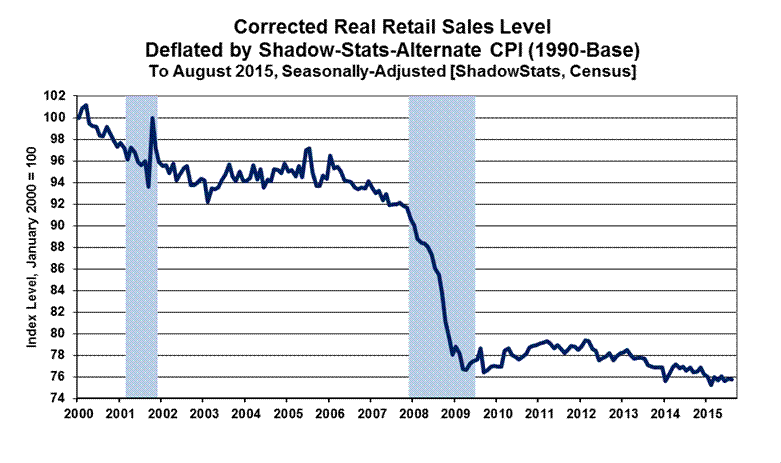
Corrected Real Retail Sales—August 2015. The apparent “recovery” of headline real retail sales shown in Graph 11 generally continued into late-2014, although headline reporting turned down in December 2014, into first-quarter 2015 and has turned higher, again. Nonetheless, headline real growth in retail sales continues to be overstated heavily, due to the understatement of the rate of inflation used in deflating the retail sales series. Discussed more fully in Chapter 9 of 2014 Hyperinflation Report—Great Economic Tumble – Second Installment, deflation by too-low an inflation number (such as the CPI-U) results in the deflated series overstating inflation-adjusted economic growth.
Both of the accompanying graphs are indexed to January 2000 = 100.0 to maintain consistency in the series of graphs related to corrected inflation-adjustment (including the regular plots of industrial production, new orders for durable goods and GDP). The first graph reflects the official real retail sales series, except that it is indexed, instead of being expressed in dollars. The plotted patterns of activity and rates of growth are exactly same for the official series, whether the series is indexed or expressed in dollars, as can be seen in a comparison of Graph 11 with Graph 19 of real retail sales in the Reporting Detail section.
Instead of being deflated by the CPI-U, the "corrected" real retail sales numbers—in Graph 12—use the ShadowStats-Alternate Inflation Measure (1990-Base) for deflation. With the higher inflation of the ShadowStats measure, the revamped numbers show a pattern of plunge and stagnation and renewed downturn, consistent with patterns seen in consumer indicators like real average weekly earnings (see Graph 13), consumer confidence, broad unemployment and in most housing statistics (see the Opening Comments and Commentary No. 744). A topping out in late-2011 and early-2012 reverted to renewed decline in second-quarter 2012 in this series, which had been bottom-bouncing at a low-level plateau of economic activity since the economic collapse into 2009. The renewed contraction has trended into and deepened into the first eight months of 2015, allowing for the occasional and temporary upside blips.
Real Average Weekly Earnings—August 2015—Third-Quarter Trend Remained Flat. Coincident with the reporting of a headline, seasonally-adjusted monthly decline of 0.11% (-0.11%) in the August 2015 CPI-W, the BLS also published real average weekly earnings for the month of August (deflated by CPI-W). The headline contraction in the August CPI-W followed a headline monthly gain of 0.13% in the July 2015 inflation measure.
In the production and nonsupervisory employees category—the only series for which there is a meaningful history—headline real average weekly earnings in August 2015 were boosted by the negative headline inflation to headline monthly gain of 0.35%, versus a revised 0.06% gain July and against a unrevised "unchanged" 0.01% in June. The August reporting and July revision reflected the usual BLS surveying and seasonal-factor instabilities common to earnings reporting. Before inflation adjustment, nominal August earnings rose by 0.2%, July earnings rose by a revised 0.2%, and June earnings rose by an unrevised of 0.3%.
Quarterly Contractions. Second-quarter 2015 real earnings showed an unrevised annualized contraction of 2.22% (-2.22%), versus an unrevised 6.22% annualized quarterly gain in first-quarter 2015. Based solely on July and August reporting, third-quarter growth is on track for minimal, annualized growth of 0.62%.
Annual Change. Year-to-year and seasonally-adjusted, August 2015 real average weekly earnings rose by 2.14%, versus a revised 2.15% in July 2015 and an unrevised 2.21% gain June 2015. Unadjusted, year-to-year change was 3.59% in August 2015, versus a revised 2.26%in July 2015 and an unrevised 0.65% gain in June 2015. Both the monthly and annual fluctuations in this series are irregular, but current reporting remains well within the normal bounds of volatility, with the exception of unusual patterns seen particularly in first-quarter 2015 inflation numbers that had been depressed by falling gasoline prices.
Graph 13 plots this series, showing earnings as officially deflated by the BLS (red-line), and as adjusted for the ShadowStats-Alternate CPI Measure, 1990-Base (blue-line). When inflation-depressing methodologies of the 1990s began to kick-in, the artificially-weakened CPI-W (also used in calculating Social Security cost-of-living adjustments) helped to prop up the reported real earnings. Official real earnings today still have not recovered their inflation-adjusted levels of the early-1970s, and, at best, have been flat for the last decade. Deflated by the ShadowStats measure, real earnings have been in fairly-regular decline for the last four decades, which is much closer to common experience than the pattern suggested by the CPI-W. See Public Commentary on Inflation Measurement for further detail.
Graph 13: Real Average Weekly Earnings 1965 to August 2015
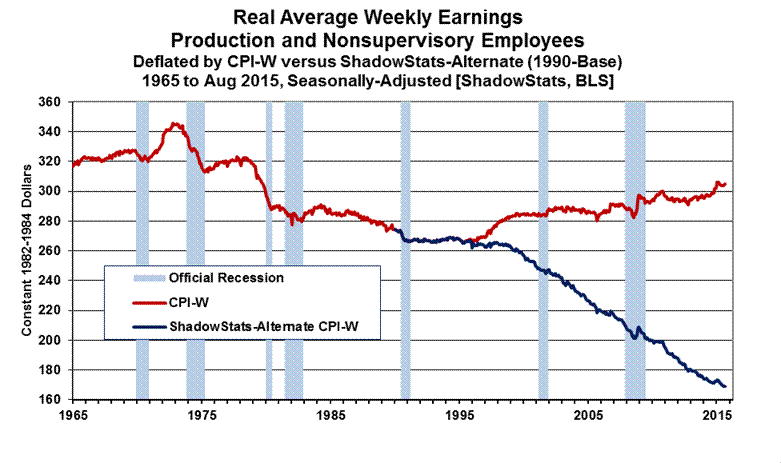
[The Reporting Detail section includes expanded detail on
the CPI and Related Real Retail and Earnings series.]
__________
HYPERINFLATION WATCH
GOLD GRAPHS, FOMC AND THE U.S. DOLLAR
Monthly Gold Graphs and Related Comments. The three traditional gold graphs (Graphs 15, 16 and 17) that accompany the CPI Commentaries follow at the end of this section. The "Latest September" points in the graphs reflect mid-afternoon New York prices for September 16th. The various plots, including Graph 14 of the U.S. dollar, also reflect activity of recent months and years.
Despite any prospective FOMC action, inaction or continued befuddlement, tomorrow (September 17th), near-term news on the U.S. economy generally still should come in well below market expectations. While a current rate hike remains likely, as discussed in Commentary No. 750, the dynamics of intensifying shifts in global perceptions of U.S. economic activity and U.S. systemic stability rapidly should gain dominance in driving the U.S. currency and equity markets, irrespective of any Fed activity or lack of same.
The myriad negative implications of an intensifying downturn in U.S. business activity should trigger heavy selling pressure against the U.S. currency. As the developing sell-off in the U.S. dollar gains broadly-based momentum, offsetting sharp rallies should be seen, on a coincident basis, for gold and silver prices, as well as for oil prices.
Graph 14: Financial- versus Trade-Weighted U.S. Dollar
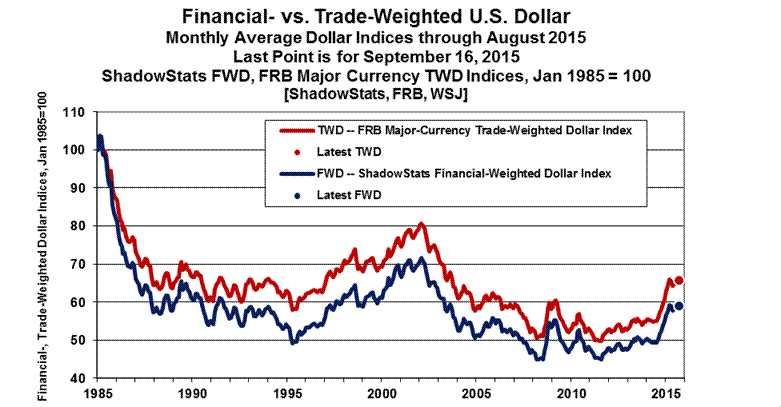
Graph 15: Gold versus the Swiss Franc
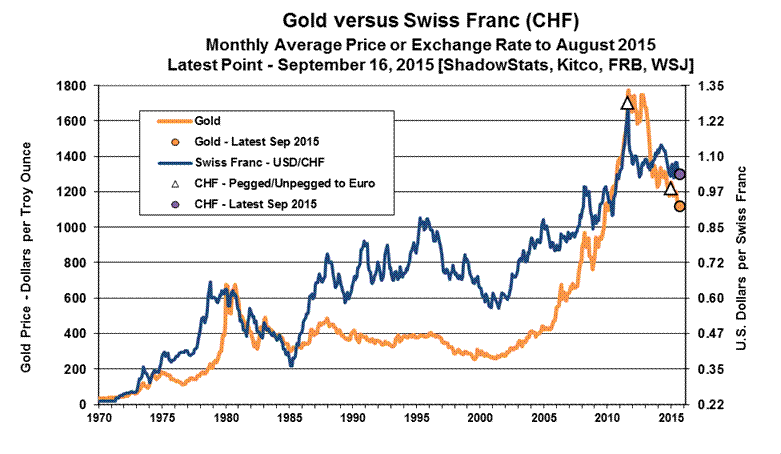
Graph 16: Gold versus Oil
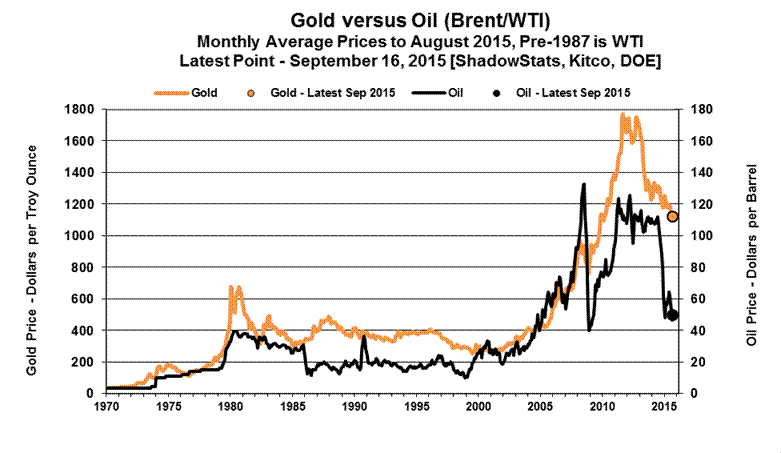
Continuing strength in the exchange-rate value of the U.S. dollar against other major Western currencies remains the primary distorting element in various financial markets and global circumstances. Global financial markets have become increasingly vulnerable to shocks, along with mounting domestic and global economic and political instabilities. ShadowStats continues to look for a massive flight from the U.S. dollar in the year ahead, to the stronger Western currencies and precious metals, likely much sooner than later, and quite possibly with little advance warning. The various issues were discussed recently in the August 10th No. 742 Special Commentary: A World Increasingly Out of Balance and in Commentary No. 743 of August 17th.
Graph 17: Gold versus Silver
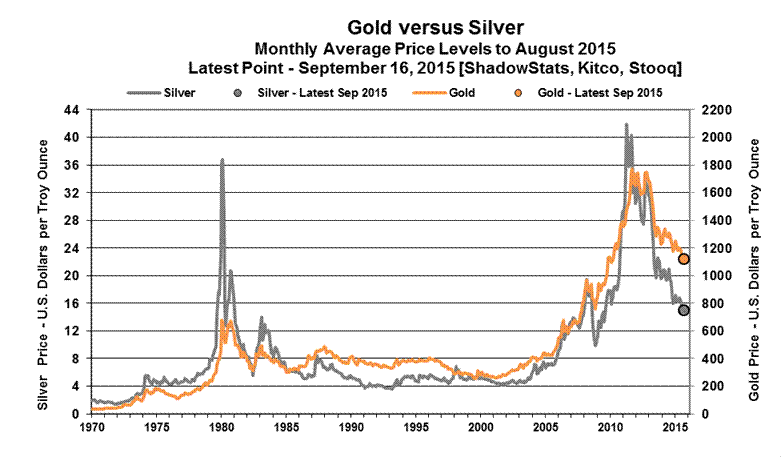
HYPERINFLATION OUTLOOK SUMMARY
Broad Outlook Is Unchanged: Economy Remains in Downturn; Dollar Faces Massive Decline with Ongoing Implications for Hyperinflation. Other than for updated internal links and references, or minor language editing, the Hyperinflation Outlook Summary is unrevised.
Background Documents to this Summary. Underlying this Summary are No. 742 Special Commentary: A World Increasingly Out of Balance of August 10th, and No. 692 Special Commentary: 2015 - A World Out of Balance of February 2, 2015, which updated the Hyperinflation 2014 reports and the broad economic outlook. Previously, the long-standing hyperinflation and economic outlooks were updated with the publication of 2014 Hyperinflation Report—The End Game Begins – First Installment Revised, on April 2, 2014, and publication of 2014 Hyperinflation Report—Great Economic Tumble – Second Installment, on April 8, 2014. The two 2014 Hyperinflation Report installments, however, remain the primary background material for the hyperinflation and economic analyses and forecasts. In terms of underlying economic reality, one other reference is the Public Commentary on Inflation Measurement. The regular Commentaries also update elements of the general outlook, as circumstances develop.
Primary Summary. The U.S. economy remains in ongoing downturn, while the U.S. dollar still faces a massive decline. Those factors, in confluence with extreme domestic fiscal imbalances, have implications for a meaningful upturn in domestic inflation evolving into a great hyperinflationary crisis.
Signs of systemic instability continue to mount, as the Fed faces the question of raising interest rates on Thursday, September 17th (see Commentary No. 750). The Fed’s protracted unwillingness and/or inability to act decisively on increasing interest rates has been symptomatic of a financial system in serious distress. Continued inaction or waffling by the Fed is likely to trigger a shift in focus and concerns, of both the domestic and global financial markets, into the area of systemic instabilities, prospective or otherwise, that are so troubling to the U.S. central bank.
Current fiscal conditions show the effective long-term insolvency of the U.S. government, a circumstance that usually would be met by eventual, unfettered monetization of the national debt and obligations, leading to a hyperinflation. As first estimated by ShadowStats in 2004, such hyperinflation appeared likely by 2020. That time horizon for the hyperinflation forecast was moved to 2014, because of the 2008 Panic, the near-collapse of the financial system, and official (U.S. government and Federal Reserve) responses to same. That hyperinflation forecast remains in place, but it has been adjusted to 2015 or 2016, as discussed in No. 742 and No. 692.
The basic story of how and why this fiscal, financial and economic crisis has unfolded and developed over the years—particularly in the last decade—is found in the Opening Comments and Overview and Executive Summary of the 2014 Hyperinflation Report—The End Game Begins—First Installment Revised.
Dollar Circumstance. Discussed in the background documents, the U.S. dollar rallied sharply from mid-2014 into early-2015, initially reflecting likely covert financial sanctions and oil-price manipulations by the United States, aimed at creating financial stresses for Russia, in the context of the Ukraine situation. Relative U.S. economic strength, and the relative virtuousness of Fed monetary policy versus major U.S. trading partners, were heavily picked-up on and over-estimated by global markets looking to support the dollar.
The still unfolding, weakening domestic-economic circumstance in 2015, in confluence with other fundamental issues, had begun to raise doubts in the markets as to the sustainability of the purported U.S. economic recovery, and as to the imminence of meaningful monetary tightening by the U.S. Federal Reserve. As a result, the U.S. dollar briefly backed off its highs, with some related upside pressure having been seen on oil prices. Pressures reversed recently, spiking the U.S. dollar—also hitting oil prices anew—with false domestic economic strength being touted by Wall Street, and with some in the Fed indicating that interest rates would be raised in September, irrespective of negative indications on the economy. Coincident, with these events, not-so-covert central-bank actions appear to have driven the price of gold lower, also in the context of mounting global financial-market instabilities.
The U.S. economy remains in contraction (see Commentary No. 747 and the Commentary No. 751), with a variety of key indicators, such as industrial production, real retail sales and revenues of the S&P 500 companies showing recession. Although formal recognition could take months, consensus recognition of a "new" recession should gain relatively rapidly, in tandem with a variety of monthly, quarterly and annual data reflecting the downturn in business activity. When formal recognition comes, timing of the onset of the "new" recession likely will be December 2014.
As market expectations move towards an imminent, new recession, such should reduce not only expectations for a significant tightening in Fed policy—if the Fed has not tightened already—but also renew expectations for a more-accommodative or newly-accommodative Fed. While such could help to fuel further stock-market mania, any resulting rallies in equity prices likely will be more than offset in real terms, by percentage declines in the exchange-rate value of the U.S. dollar or in the eventual increases in headline consumer inflation.
Faltering expectations on the direction of domestic economic activity, also would place mounting and eventually massive selling pressure on the U.S. dollar, as well as potentially resurrect elements of the Panic of 2008. Physical gold and silver, and holding assets outside the U.S. dollar, remain the ultimate primary hedges against an eventual total loss of U.S. dollar purchasing power. These circumstances should unwind what has been the sharp and generally ongoing rally in the U.S. dollar’s exchange rate since mid-2014, and the broadly-related selling pressures seen in the gold and silver markets. Further, oil prices should spike anew, along with a sharp reversal in the dollar’s strength.
A crash back to recognition of more-realistic domestic-economic circumstances looms, possibly in the weeks and certainly in the months ahead. It should be accompanied by a crash in the U.S. dollar versus major currencies, such as the Swiss franc, Canadian dollar and Australian dollar (currencies with some perceived ties to gold); and related rallies in precious metals and oil. Further, a sharp deterioration in the near-term outlook for domestic and global political stability continues and is of meaningful risk for fueling further heavy selling of the dollar. Once in heavy downturn, the dollar’s gains since June 2014 should reverse fully, pushing the exchange-rate value of the dollar to new historic lows. Again, the nascent currency crisis also has meaningful potential to resurrect elements of the Panic of 2008.
Unexpected economic weakness intensifies stresses on an already-impaired banking system, increasing the perceived need for expanded, not reduced, quantitative easing. The highly touted "tapering" by the FOMC ran its course. Future, more-constructive Fed behavior—moving towards normal monetary conditions in what had been an unfolding, purportedly near-perfect economic environment—was pre-conditioned by a continued flow of "happy" economic news. Suggestions that all was right again with world were nonsense. The Fed’s games now are on the brink of being played out or collapsing.
Indeed, the Fed still likely will move to normalize interest rates (see Commentary No. 750 as well as those in Commentary No. 726), if it can get away with it. The FOMC meeting of June 17th apparently concluded that the Fed could not get away with it (see Opening Comments of Commentary No. 729). Actions by the FOMC on September 17th will be telling. The Panic of 2008 never was resolved, and the Fed increasingly has found that it has no easy escape from its quantitative easing (QE3), which continues; only overt expansion of QE3 ceased. If the Fed does not act quickly to extricate itself from prior actions, QE4 will become the near-term question. Again, despite loud promises of higher rates next week, banking-system issues (not the economy) may keep the pending interest rate hike in a continual state of suspension.
Unexpected economic weakness—a renewed downturn—also savages prospective federal budget deficit prognostications (particularly the 10-year versions). Such throws off estimates of U.S. Treasury funding needs and estimates as to how long the Treasury effectively can dodge the limits of the recently re-imposed debt ceiling. Current fiscal "good news" remains from cash-based, not GAAP-based accounting projections and is heavily impacted by changes in business activity.
The economy has not recovered; the banking system is far from stable and solvent; and the Federal Reserve and the federal government still have no way out. Significant banking-system and other systemic (i.e. U.S. Treasury) liquidity needs will be provided, as needed, by the Fed, under the ongoing political cover of a weakening economy—a renewed, deepening contraction in business activity. The Fed has no choice. Systemic collapse is not an option for the Board of Governors. This circumstance simply does not have a happy solution.
Accordingly, any significant, renewed market speculation in the near future, as to an added round of Federal Reserve quantitative easing, QE4, may become a major factor behind crashing the dollar and boosting the price of gold. The Fed has strung out its options for propping up the system as much as it thought it could, with continual, negative impact on the U.S. economy. The easings to date, however, appear to have been largely a prop to banking system and to the increasingly unstable equity markets.
While higher domestic interest rates would tend to act as a dollar prop, a hike in rates also could crash the stock market, as some on Wall Street fear, triggering a round of other systemic problems. Again, there is no happy way out of this for the Fed.
The fundamental problems threatening the U.S. dollar could not be worse. The broad outlook has not changed; it is just a matter of market perceptions shifting anew, increasingly against the U.S. currency. That process likely will become dominated by deteriorating global perceptions of stability in U.S. economic activity and the ability of the Federal Reserve to control its monetary policy. Key issues include, but are not limited to:
· A severely damaged U.S. economy, which never recovered post-2008, is turning down anew, with no potential for recovery in the near-term. The circumstance includes a renewed widening in the trade deficit and contracting production, as well as ongoing severe, structural-liquidity constraints on the consumer, which are preventing a normal economic rebound in the traditional, personal-consumption-driven U.S. economy (see Commentary No. 748). Sharply-negative economic reporting shocks, versus softening consensus forecasts, still remain a heavily-favored, proximal trigger for intensifying the pending dollar debacle.
· U.S. government unwillingness to address its long-term solvency issues. Those controlling the U.S. government have demonstrated not only a lack of willingness to address long-term U.S. solvency issues, but also the current political impossibility of doing so. The shift in control of Congress did not alter the systemic unwillingness to address underlying fundamental issues, specifically to bring the GAAP-based deficit into balance. Any current fiscal "good news" comes from cash-based, not GAAP-based accounting projections. The GAAP-based version continues to run around $5 trillion for the annual shortfall, with total net obligations of the U.S. government pushing $100 trillion, including the net present value of unfunded liabilities. Still, many in Washington look to continue increasing spending and to take on new, unfunded liabilities. This circumstance now operates in the context of the formal constraint of a renewed debt ceiling.
· Monetary malfeasance by the Federal Reserve, as seen in central bank efforts to provide liquidity to a troubled banking system, and also to the U.S. Treasury. Despite the end of the Federal Reserve’s formal asset purchases, the U.S. central bank monetized 78% of the U.S. Treasury’s fiscal-2014 cash-based deficit (see Commentary No. 672). The quantitative easing QE3 asset purchase program effectively monetized 66% of the total net issuance of federal debt to be held by the public during the productive life of the program (beginning with the January 2013 expansion of QE3). The 2014 monetization process was completed with the Federal Reserve refunding the interest income it earned on the Treasury securities to the U.S. Treasury, but more of that lies ahead. If the Fed does not move soon to boost interest rates, it may be trapped in a renewed expansion of quantitative easing, given ongoing banking-system stresses, vulnerable stock markets and weakening, actual U.S. economic activity. As has been commonplace, the Fed likely would seek political cover for any new or expanded systemic accommodation in any the intensifying economic distress.
· Mounting domestic and global crises of confidence in a dysfunctional U.S. government. The positive rating by the public of the U.S. President tends to be an indicative measure of this circumstance, usually with a meaningful correlation with the foreign-exchange-rate strength of the U.S. dollar. The weaker the rating, the weaker tends to be the U.S. dollar. The positive rating for the President is off its historic low, but still at levels that traditionally are traumatic for the dollar. Chances of a meaningful shift towards constructive cooperation between the White House and the new Congress in addressing fundamental fiscal and economic issues are nil. Issues such as non-recovered, faltering economic activity, the consumer liquidity crisis and the nation’s long-range solvency should continue to devolve into extreme political crises.
· Mounting global political pressures contrary to U.S. interests. Downside pressures on the U.S. currency generally are intensifying, or sitting in place, in the context of global political and military developments contrary to U.S. strategic, financial and economic interests. Current conditions include the ongoing situation versus Russia and extraordinarily-volatile circumstances in the Middle East. U.S. response to Russian activity in the Ukrainian situation likely was behind part of the recent strength in the U.S. dollar and related weakness in oil prices, with U.S. actions aimed at causing financial distress for Russia. These situations have yet to run their full courses, and they have the potential for rapid and massive negative impact on the financial and currency markets.
· Spreading global efforts to dislodge the U.S. dollar from its primary reserve-currency status. Active efforts or comments against the U.S. dollar continue to expand. In particular, anti-dollar rhetoric and actions have been seen with Russia, China, France, India and Iran, along with some regular rumblings in OPEC and elsewhere. Temporary, recent dollar strength may have bought some time versus those who have to hold dollars for various reasons. Nonetheless, developing short-term global financial instabilities and a quick, significant reversal in the dollar’s strength should intensify the "dump-the-dollar" rhetoric rapidly. Consider that China has been selling some of its U.S. Treasury debt holdings to raise cash in for its near-term financial needs. Again, much of the rest of the world also has been backing away from holding U.S. treasury securities.
When the selling pressure breaks massively against the U.S. currency, the renewed and intensifying weakness in the dollar will place upside pressure on oil prices and other commodities, boosting domestic inflation and inflation fears. Domestic willingness to hold U.S. dollars will tend to move in parallel with global willingness, or lack of willingness, to do the same. These circumstances will trigger the early stages of a hyperinflation, still likely in the year ahead.
Both the renewed dollar weakness and the resulting inflation spike should boost the prices of gold and silver, where physical holding of those key precious metals remains the ultimate hedge against the pending inflation and financial crises. Investors need to preserve the purchasing power and liquidity of their wealth and assets during the hyperinflation crisis ahead. See Chapter 10, 2014 Hyperinflation Report—Great Economic Tumble for detailed discussion on approaches to handing the hyperinflation crisis and No. 742, for other factors afoot in the current environment.
__________
REPORTING DETAIL
CONSUMER PRICE INDEX—CPI (August 2015)
Headline August CPI-U Dropped by 0.1%(-0.1%) with Falling Gasoline Prices; Annual Inflation Was Up by 0.2% for a Third Consecutive Positive Reading. [The paragraphs down to the "Longer-range Outlook…" largely are repeated from or covered in the Opening Comments.] August 2015 CPI-U declined month-to-month by 0.07% (-0.07%), near consensus expectations ranging from a decline of 0.1% (-0.1%) to "unchanged" [MarketWatch and Bloomberg]. After six straight months of a positive headline monthly inflation reading, "deflation"—created by declining gasoline prices—re-surfaced, despite positive seasonal adjustments for gasoline prices. Above zero for the third consecutive month, though, year-to-year CPI-U inflation rose by a headline 0.20%, per the Bureau of Labor Statistics (BLS).
Going forward, annual inflation readings should continue positive, thanks to annual inflation comparisons increasingly going against softer inflation of a year ago, which had been hit then by collapsing oil and gasoline prices.
A sustained increase in energy prices would push headline CPI-U inflation sharply higher, and the current downturn in oil prices, again, should prove fleeting. Distorted oil industry economics and wavering Cartel gimmicks increasingly should alter circumstances in favor of maintaining upside, short-term pricing pressures. Near-term selling pressure against the U.S. dollar also should mount and then intensify, quickly becoming the dominant factor spiking dollar-denominated oil prices and other inflationary pressures.
Separately, although the pace of annual CPI-U inflation has held just above zero for the third time since December 2014, year-to-year inflation is not and has not been quite as soft as indicated by headline reporting, when considered in the context of traditional CPI reporting and common experience. The ShadowStats Alternate Inflation Measures held at 3.8% annual inflation in August, the same level as July, based on 1990 methodologies, and held at 7.8% annual inflation in August, same as in July, based on 1980 methodologies.
[The next three paragraphs are not changed from the prior Commentary except for minor cleanup of language and updated internal references.]
Government Inflation Numbers Standardly Are Well Shy of Reality. Inflation as viewed from the standpoint of common experience—generally viewed by the public in terms of personal income or investment use—continues to run well above any of the government’s rigged, headline inflation measures. CPI reporting methodologies in recent decades deliberately were changed so as to understate the government’s reporting of consumer inflation, and that inflation-understatement fraud is being expanded with movement towards more-standard use of the C-CPI-U (see below). The pace of inflation has been understated, through politically-orchestrated efforts to adjust for economic substitutions in the CPI surveying (i.e., hamburger being purchased in lieu of more-expensive steak), and by not reflecting actual out-of-pocket costs in its surveying, with generally downside hedonic-quality adjustments made to prices, all as detailed in the Public Commentary on Inflation Measurement. That Public Commentary will be updated in the near future for changing CPI methodologies and continued exposition on the ShadowStats approaches for adjusting to same.
Contrary to its traditional structure, the CPI no longer reflects the cost of living of maintaining a constant standard of living. As a result, those who set or target their income or investment growth to the government’s faux headline CPI number simply cannot stay even with inflation, unless they massively exceed their targets. Allowing for the earlier CPI methodologies, actual year-to-year consumer inflation is not close to being flat, zero or minus (see the ShadowStats Alternate Inflation Measures).
Longer-Range Inflation Outlook. Discussed generally in No. 742 Special Commentary: A World Increasingly Out of Balance, No. 692 Special Commentary: 2015 - A World Out of Balance and 2014 Hyperinflation Report—The End Game Begins – First Installment Revised, high risk of an massive flight from the U.S. dollar in the months ahead threatens to generate rapid, upside energy and global-commodity inflation, which would drive headline U.S. consumer inflation much higher. Nascent dollar problems appear to be surfacing and could accelerate at any time, with little further warning. Intensifying financial-market turmoil surrounding deteriorating global and domestic political, fiscal and monetary instabilities, and rapidly worsening economic activity, all should pummel the U.S. dollar (see No. 742, linked above). Ongoing economic and financial-system-liquidity crises still threaten systemic instabilities that, as with their 2008 Panic precursors, cannot be contained without further, official actions that have serious inflation consequences.
__________________
Notes on Different Measures of the Consumer Price Index
The Consumer Price Index (CPI) is the broadest inflation measure published by the U.S. Government, through the Bureau of Labor Statistics (BLS), Department of Labor:
The CPI-U (Consumer Price Index for All Urban Consumers) is the monthly headline inflation number (seasonally adjusted) and is the broadest in its coverage, representing the buying patterns of all urban consumers. Its standard measure is not seasonally-adjusted, and it never is revised on that basis except for outright errors.
The CPI-W (CPI for Urban Wage Earners and Clerical Workers) covers the more-narrow universe of urban wage earners and clerical workers and is used in determining cost of living adjustments in government programs such as Social Security. Otherwise, its background is the same as the CPI-U.
The C-CPI-U (Chain-Weighted CPI-U) is an experimental measure, where the weighting of components is fully substitution based. It generally shows lower annual inflation rate than the CPI-U and CPI-W. The latter two measures once had fixed weightings—so as to measure the cost of living of maintaining a constant standard of living—but now are quasi-substitution-based. Since it is fully substitution based, the series tends to reflect lower inflation than the other CPI measures. Accordingly, the C-CPI-U is the "new inflation" measure being proffered by Congress and the White House as a tool for reducing Social Security cost-of-living adjustments by stealth. Moving to accommodate the Congress, the BLS introduced changes to the C-CPI-U estimation process with the February 26, 2015 reporting of January 2015 inflation, aimed at finalizing the C-CPI-U estimates on a more-timely basis, and enhancing its ability to produce lower headline inflation than the traditional CPI-U.
The ShadowStats Alternative CPI-U Measures are attempts at adjusting reported CPI-U inflation for the impact of methodological change of recent decades designed to move the concept of the CPI away from being a measure of the cost of living needed to maintain a constant standard of living. There are two measures, where the first is based on reporting methodologies in place as of 1980, and the second is based on reporting methodologies in place as of 1990.
__________________
CPI-U. The Bureau of Labor Statistics (BLS) reported this morning, September 26th, that headline, seasonally-adjusted August 2015 CPI-U fell month-to-month by 0.1% (-0.1%), down by 0.07% (-0.07%) at the second decimal point, following a headline month-to-month gain of 0.1%, up by 0.13% at the second decimal point. Adjusted headline inflation was boosted in August by seasonal factors. On a not-seasonally-adjusted basis, the August 2015 CPI-U was down by 0.14% (-0.14%) month-to-month, following an unadjusted 0.17% gain in July.
Monthly gasoline-inflation seasonal adjustments were positive for August 2015, but not enough to turn headline inflation positive. The BLS reported unadjusted gasoline prices down by 5.43% (-5.43%) for the month, versus a drop of 5.35% (-5.35%) on a not-seasonally-adjusted basis, per the Department of Energy (DOE). Seasonally-adjusted gasoline prices still fell by 4.05% (-4.05%) in August, per the BLS. Aggregate energy-inflation seasonal adjustments also were positive for the month.
Major CPI-U Groups. Encompassed by the seasonally-adjusted decline of 0.07% (-0.07%) in the August 2015 CPI-U [down by an unadjusted 0.14% (-0.14%)], aggregate August energy inflation fell for the month by a seasonally-adjusted 2.03% (-2.03%) [down by an unadjusted 3.00% (-3.00%)]. In the other major CPI sectors, adjusted August food and beverage inflation was up by 0.23% [up by 0.26% unadjusted], while adjusted "core" inflation rose by 0.07% [up by 0.09% unadjusted] for the month. Separately, core CPI-U inflation showed unadjusted year-to-year inflation of 1.83% in August 2015, versus 1.80% in July 2015.
Year-to-Year CPI-U. Not seasonally adjusted, August 2015 year-to-year inflation for the CPI-U increased by 0.2%, up by 0.20% at the second decimal point, following a headline gain of 0.2%, up by 0.17% at the second decimal point in July 2015.
Year-to-year, CPI-U inflation would increase or decrease in next month’s September 2015 reporting, dependent on the seasonally-adjusted monthly change, versus the adjusted, headline inflation gain of 0.09% for September 2014. The adjusted change is used here, since that is how consensus expectations are expressed. To approximate the annual unadjusted inflation rate for September 2015, the difference in September’s headline monthly change (or forecast of same), versus the year-ago monthly change, should be added to or subtracted directly from the August 2015 positive annual inflation rate of 0.20%. For example, a seasonally headline monthly gain of 0.1% in September 2015 CPI-U would leave annual September 2015 inflation around 0.2% (0.1% - 0.09% + 0.20%), depending on rounding.
CPI-W. The August 2015 seasonally-adjusted, headline CPI-W, which is a narrower series and has greater weighting for gasoline than does the CPI-U, fell month-to-month by an adjusted 0.11% (-0.11%), down unadjusted by 0.19% (-0.19%), versus an adjusted gain of 0.13% (unchanged at 0.00% unadjusted) in July.
Year-to-Year CPI-W. Unadjusted, August 2015 year-to-year CPI-W inflation fell by 0.28% (-0.28%), slightly narrowed from an annual decline of 0.31% (-0.31%) in July 2015. The recent annual contractions in the unadjusted CPI-W hit their nadir in April 2015, down year-to-year by 0.82% (-0.82%).
Chained-CPI-U. Initial reporting of unadjusted year-to-year inflation for the August 2015 C-CPI-U was a decline of 0.13% (-0.13%), versus a contraction of 0.12% (-0.12%) in July.
See the discussions in the earlier CPI Commentary No. 721 and in the opening notes in the CPI Section of Commentary No. 699 as to recent changes in the series. More-frequent revisions and earlier finalization of monthly detail are designed to groom the C-CPI-U series as the new Cost of Living Adjustment (COLA) index of choice for the budget-deficit-strapped federal government.
Alternate Consumer Inflation Measures. Adjusted to pre-Clinton methodologies—the ShadowStats-Alternate Consumer Inflation Measure (1990-Base)—year-to-year annual inflation was roughly 3.8% in August 2015, the same level as the 3.8% in July 2015.
The August 2015 ShadowStats-Alternate Consumer Inflation Measure (1980-Base), which reverses gimmicked changes to official CPI reporting methodologies back to 1980, was at about 7.8% (7.80% for those using a second decimal point) year-to-year, versus 7.8% in July 2015.
Note: The ShadowStats-Alternate Consumer Inflation Measures largely have been reverse-engineered from the components of the BLS’s CPI-U-RS series. That series provides an official estimate of historical inflation, assuming that all current methodologies were in place going back in time. The changes reflected there are parallel with and of the same magnitude of change as estimated by the BLS, when a given methodology was changed. The ShadowStats estimates are adjusted on an additive basis for the cumulative impact on the annual inflation rate from the various BLS changes in methodology (reversing the net aggregate inflation reductions by the BLS). The series are adjusted by ShadowStats for those aggregate changes, but the series otherwise are not recalculated.
Over the decades, the BLS has altered the meaning of the CPI from being a measure of the cost of living needed to maintain a constant standard of living, to something that neither reflects the constant-standard-of-living concept nor measures adequately what most consumers view as out-of-pocket expenditures. Roughly five percentage points of the additive ShadowStats adjustment since 1980 reflect the BLS’s formal estimate of the annual impact of methodological changes; roughly two percentage points reflect changes by the BLS, where ShadowStats has estimated the impact not otherwise published by the BLS. For example, the BLS does not consider more-frequent weightings of the CPI series to be a change in methodology. Yet that change has had the effect of reducing headline inflation from what it would have been otherwise (See Public Commentary on Inflation Measurement for further details.)
Gold and Silver Historic High Prices Adjusted for August 2015 CPI-U/ShadowStats Inflation—
CPI-U: GOLD at $2,604 per Troy Ounce, SILVER at $151 per Troy Ounce
ShadowStats: GOLD at $12,163 per Troy Ounce, SILVER at $708 per Troy Ounce
Despite the September 5, 2011 historic-high gold price of $1,895.00 per troy ounce (London afternoon fix), and despite the multi-decade-high silver price of $48.70 per troy ounce (London fix of April 28, 2011), gold and silver prices have yet to re-hit their 1980 historic levels, adjusted for inflation. The earlier all-time high of $850.00 (London afternoon fix, per Kitco.com) for gold on January 21, 1980 would be $2,604 per troy ounce, based on August 2015 CPI-U-adjusted dollars, and $12,163 per troy ounce, based on August 2015 ShadowStats-Alternate-CPI (1980-Base) adjusted dollars (all series not seasonally adjusted).
In like manner, the all-time high nominal price for silver in January 1980 of $49.45 per troy ounce (London afternoon fix, per silverinstitute.org)—although approached in 2011—still has not been hit since 1980, including in terms of inflation-adjusted dollars. Based on August 2015 CPI-U inflation, the 1980 silver-price peak would be $151 per troy ounce and would be $708 per troy ounce in terms of August 2015 ShadowStats-Alternate-CPI (1980-Base) adjusted dollars (again, all series not seasonally adjusted).
As shown in Table 1, on page 31 of 2014 Hyperinflation Report—The End Game Begins – First Installment Revised, over the decades, the increases in gold and silver prices have compensated for more than the loss of the purchasing power of the U.S. dollar as reflected by CPI inflation. They also effectively have come close to fully compensating for the loss of purchasing power of the dollar based on the ShadowStats-Alternate Consumer Price Measure (1980-Methodologies Base).
Graph 18: Monthly Average Gold Price in Dollars (Federal Reserve Notes)
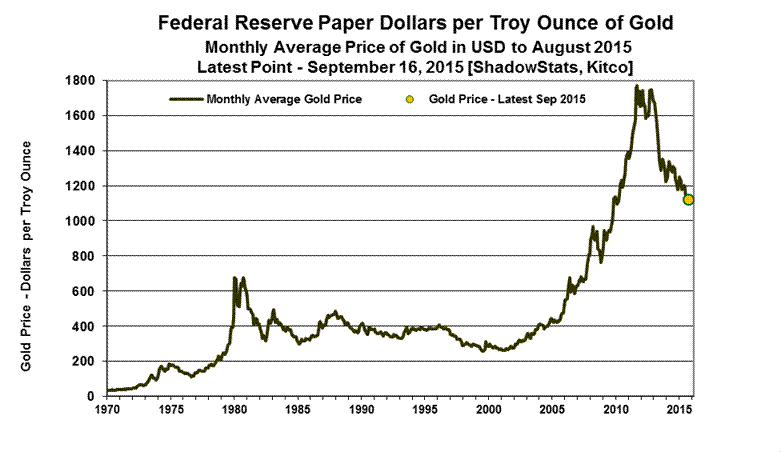
Real (Inflation-Adjusted) Retail Sales—August 2015—Monthly Nominal Growth of 0.19% Boosted to 0.26% by Headline CPI-U Contraction of 0.07% (-0.07%); Recession Signal Continued. Not adjusted for inflation, headline nominal retail sales rose by 0.19% in August 2015, following an upwardly revised gain of 0.71% [previously up by 0.57%] in July 2015, as detailed in yesterday’s Commentary No. 751 of September 15th. Year-to-year growth in August 2015 nominal retail sales was 2.16%, versus an upwardly revised 2.59% [previously 2.43%] annual gain in July 2015.
Headline Reporting of Real Retail Sales. Based on today’s (September16th) reporting of a headline monthly contraction of 0.07% (-0.07%) in the August 2015 CPI-U, and in the context of a 0.13% gain in the July CPI-U, August real retail sales rose month-to-month by 0.26%, while July 2015 real retail sales rose by a revised 0.57% [previously up by 0.44%], more than offsetting a revised monthly decline in June real retail sales of 0.36% (-0.36%) [previously down by 0.31% (-0.31%)].
Where first-quarter 2015 real retail sales contracted at an unrevised annualized pace of 1.02% (-1.02%), annualized growth for second-quarter 2015 revised to 3.72% [previously up by 3.78%], while third-quarter growth—based solely on the initial reporting for July and August—showed an early indication of a 2.87% gain [previously up by 1.92% based solely on initial July reporting].
Real Year-to-Year Growth Still Generated a Continuing Recession Signal. With seasonally-adjusted headline year-to-year CPI-U inflation up by 0.22% in August 2015, and up by 0.21% in July 2015, year-to-year growth in August 2015 real retail sales was 1.94%, versus a downwardly revised annual gain in July 2015 of 2.38% [previously up 2.43%] and a downwardly revised annual gain of 1.60% [previously up by 1.83%] in June 2015.
In normal economic times, annual real growth at or below 2.0% signals an imminent recession. That signal had been given most recently in February, April and June 2015, indicating a deepening downturn. Although those readings have been interspersed with somewhat higher readings in March, May and July, August dropped below the threshold again, with an average level of real year-to-year growth for the last six months at 1.98%. Current reporting remains consistent with a signal of imminent recession. Graphs 20 and 22, following, show the latest patterns of headline annual real growth in retail sales.
Discussed in today’s Opening Comments, the primary issues constraining headline retail sales activity remain intense, structural-liquidity woes besetting the consumer. That circumstance—in the last eight-plus years of economic collapse and stagnation—has continued to prevent a normal recovery in broad U.S. economic activity. Without real growth in household income and without the ability or willingness to take on meaningful new debt, the consumer simply has not had the wherewithal to fuel sustainable growth real personal consumption.
As official consumer inflation moves higher in the months ahead, and as overall retail sales continue to suffer from the ongoing consumer liquidity squeeze—reflected partially by the general pattern of the real earnings difficulties discussed in the next section—these data should resume trending meaningfully lower, in what shortly should gain recognition as a formal "new" or double-dip recession.
Real Retail Sales Graphs. Graph 19, the first of the four graphs following, shows the level of real retail sales activity (deflated by the CPI-U) since 2000; Graph 20 shows the year-to-year percent change for the same period. The level of headline monthly activity turned lower for the third consecutive month, in February 2015, showing signs of faltering sales. March showed some rebound, but that quarter remained in contraction. April was down, but headline activity bounced back in May, dropped in June and rebounded in July and August.
Year-to-year activity, which had plunged to a near-standstill in January and February 2014, had bounced back irregularly, hitting its recent high level in January 2015, spiked by negative inflation at the time. Yet, it fell back in February and has been fluctuating since, still generating the recession signal, as discussed earlier. Graphs 21 and 22 show the level of, and annual growth in, real retail sales (and its predecessor series) in full post-World War II detail.
Irrespective of first-quarter 2015 reporting weakness, the apparent “recovery” in the real retail sales series (and other series such as industrial production and GDP) up through year-end 2014 was due largely to the understatement of the rate of inflation used in deflating retail sales and other series. As discussed more fully in Chapter 9 of 2014 Hyperinflation Report—Great Economic Tumble – Second Installment, deflation by too-low an inflation number (such as the CPI-U) results in the deflated series overstating inflation-adjusted economic growth.
As shown in the latest "corrected" real retail sales—Graph 12 in the Opening Comments section—with the deflation rates corrected for the understated inflation reporting of the CPI-U, the recent pattern of real sales activity has turned increasingly negative. The corrected graph shows that the post-2009 period of protracted stagnation ended, and a period of renewed and ongoing contraction began in second-quarter 2012. The corrected real retail sales numbers use the ShadowStats-Alternate Inflation Measure (1990-Base) for deflation instead of the CPI-U.
Graph 19: Real Retail Sales (2000 to 2015)
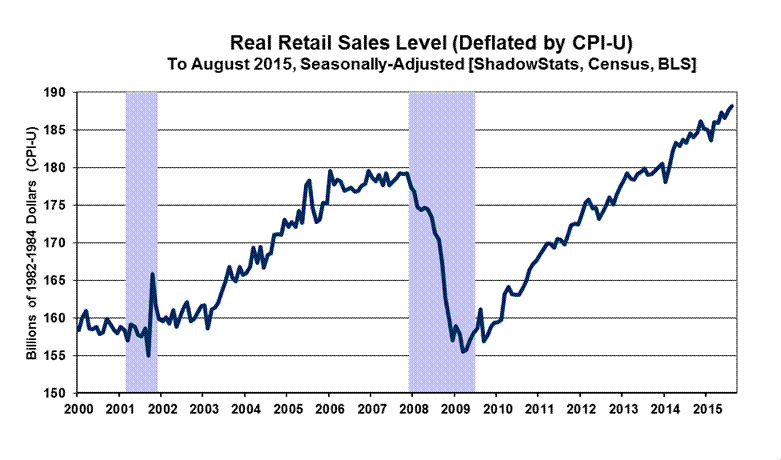
Graph 20: Real Retail Sales (2000 to 2015), Year-to-Year Percent Change
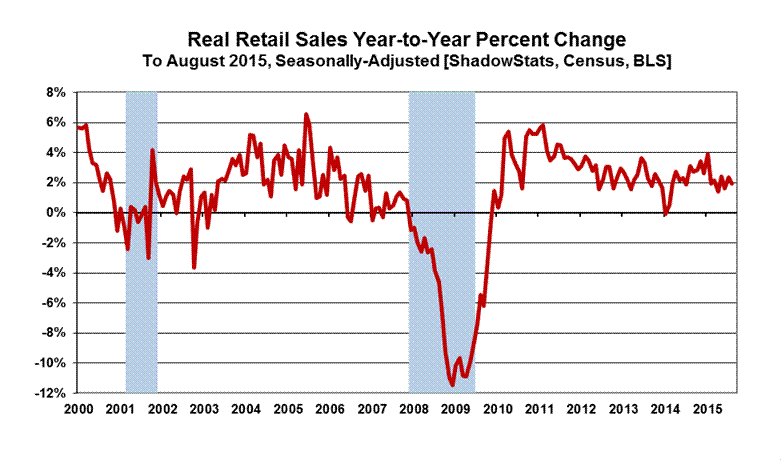
Graph 21: Real Retail Sales (1947 to 2015)
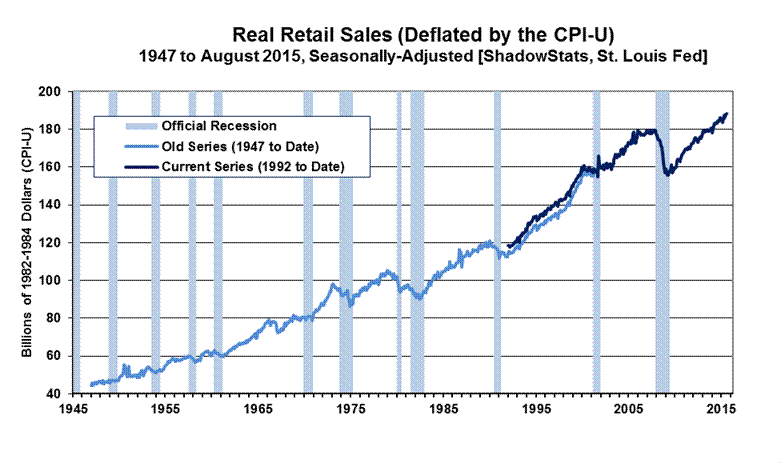
Graph 22: Real Retail Sales (1948 to 2015), Year-to-Year Percent Change
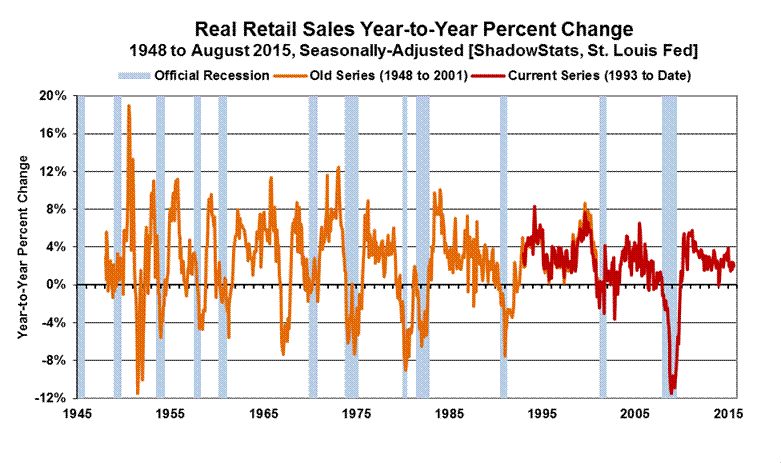
Real (Inflation-Adjusted) Average Weekly Earnings—August 2015—Third-Quarter Trend Remained Flat. Coincident with today’s (September 16th) reporting of a headline, seasonally-adjusted monthly decline of 0.11% (-0.11%) in the August 2015 CPI-W, the BLS also published real average weekly earnings for the month of August (deflated by CPI-W). The headline contraction in the August CPI-W followed a headline monthly gain of 0.13% in the July 2015 inflation measure.
In the production and nonsupervisory employees category—the only series for which there is a meaningful history—headline real average weekly earnings in August 2015 were boosted by the negative headline inflation to headline monthly gain of 0.35%, versus a revised 0.06% [previously "unchanged" 0.01%] gain July and against a unrevised "unchanged" 0.01% in June. The August reporting and July revision reflected the usual surveying and seasonal-factor instabilities by the BLS as to earnings.
Before inflation adjustment, nominal August earnings rose by 0.2%, July earnings rose by a revised 0.2% [previously up by 0.1%], and June earnings rose by an unrevised of 0.3%.
Quarterly Contractions. Second-quarter 2015 real earnings showed an unrevised annualized contraction of 2.22% (-2.22%), versus an unrevised 6.22% annualized quarterly gain in first-quarter 2015. Based solely on July and August reporting, third-quarter growth is on track for minimal, annualized growth of 0.62%. That had been an annualized contraction of 0.26% (-0.26%) based just on the July reporting.
Annual Change. Year-to-year and seasonally-adjusted, August 2015 real average weekly earnings rose by 2.14%, versus a revised 2.15% [previously up by 2.10%] in July 2015 and an unrevised 2.21% [initially 1.95%] gain June 2015. Unadjusted, year-to-year change was 3.59% in August 2015, versus a revised 2.26% [previously 2.22%] in July 2015 and an unrevised 0.65% [initially 0.70%] gain in June 2015. Both the monthly and annual fluctuations in this series are irregular, but current reporting remains well within the normal bounds of volatility, with the exception of unusual patterns seen particularly in first-quarter 2015 inflation numbers that had been depressed by falling gasoline prices.
The Graph 13, found in the Opening Comments section, plots this series, showing earnings as officially deflated by the BLS (red-line), and as adjusted for the ShadowStats-Alternate CPI Measure, 1990-Base (blue-line). When inflation-depressing methodologies of the 1990s began to kick-in, the artificially-weakened CPI-W (also used in calculating Social Security cost-of-living adjustments) helped to prop up the reported real earnings. Official real earnings today still have not recovered their inflation-adjusted levels of the early-1970s, and, at best, have been flat for the last decade. Deflated by the ShadowStats measure, real earnings have been in fairly-regular decline for the last four decades, which is much closer to common experience than the pattern suggested by the CPI-W. See Public Commentary on Inflation Measurement for further detail.
Real (Inflation-Adjusted) Money Supply M3—August 2015. The signal for a double-dip, multiple-dip or simply protracted, ongoing recession, based on annual contraction in the real (inflation-adjusted) broad money supply (M3), remains in place and continues, despite real annual M3 growth having rallied in positive territory for several years. As shown in the accompanying graph—based on August 2015 CPI-U reporting and the latest ShadowStats-Ongoing M3 Estimate—annual inflation-adjusted growth in M3 for August 2015 annual growth rose to 5.9%, versus an unrevised 5.4% in July 2015. Such reflected primarily a continued a sharp jump in the pace of nominal annual headline M3 growth (see Commentary No. 749) versus a minimally-positive swing in the annual inflation rate.
Graph 23: Real M3 Annual Growth versus Formal Recessions
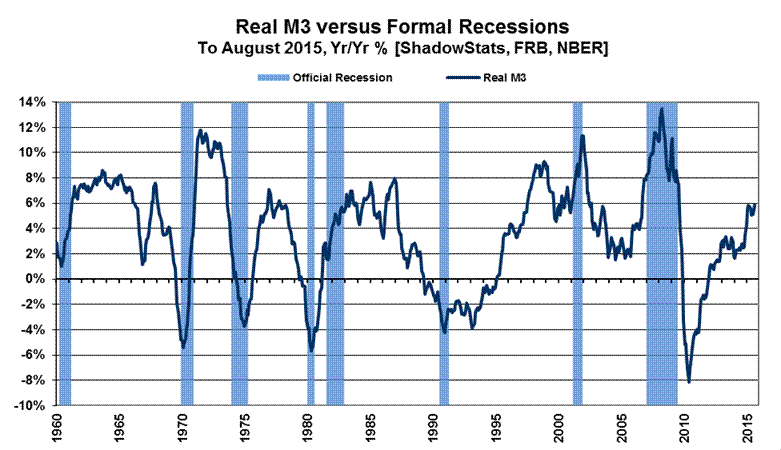
The signal for a downturn or an intensified downturn is generated when annual growth in real M3 first turns negative in a given cycle; the signal is not dependent on the depth of the downturn or its duration. Breaking into positive territory does not generate a meaningful signal one way or the other for the broad economy. The current "new" downturn signal was generated in December 2009, even though there had been no upturn since the economy purportedly hit bottom in mid-2009. Again, when real M3 growth breaks above zero, there is no signal; the signal is generated only when annual growth moves into negative territory. The broad economy tends to follow in downturn or renewed deterioration roughly six-to-nine months after the signal. Weaknesses in a number of economic series have continued to the present, with significant new softness in recent reporting. Actual post-2009 economic activity has remained at relatively low levels of activity—in protracted stagnation, with no actual recovery (see Commentary No. 739).
Despite the purported, ongoing recovery shown in headline GDP activity, a renewed downturn in official data is underway and should gain official recognition in the near future of a “new” or double-dip recession (see Hyperinflation Outlook Summary). Reality remains that the economic collapse into 2009 was followed by a plateau of low-level economic activity—no meaningful upturn, no recovery from or end to the official 2007 recession—and the unfolding renewed downturn remains nothing more than a continuation and re-intensification of the downturn that began unofficially in 2006. Further discussion of this issue is found in No. 742 Special Commentary: A World Increasingly Out of Balance of August 10th,and most broadly in Chapter 8 of the 2014 Hyperinflation Report—Great Economic Tumble – Second Installment.
__________
WEEK AHEAD
Economic Reporting Generally Should Trend Much Weaker than Expected; Inflation Will Rise Anew, Along with a Renewed Rebound in Oil Prices. Still in a fluctuating trend to the downside, amidst mixed reporting in headline data, market expectations for business activity nonetheless tend to move with the latest economic hype in the popular media. That general effect holds the consensus outlook at overly-optimistic levels, with current expectations still exceeding any potential, underlying economic reality. Again, though, the expectations trend has continued to soften.
Headline reporting of the regular monthly economic numbers increasingly should turn lower in the weeks and months ahead, along with an eventual downside revision to the recently, upwardly-revised second-quarter GDP estimate, and along with likely downside or otherwise much weaker-than-expected reporting for at least the next several quarters of GDP (and GDI and GDP) into 2016.
CPI-U consumer inflation—driven lower earlier this year by collapsing prices for gasoline and other oil-price related commodities—likely has seen its near-term, year-to-year low. It turned positive in June 2015, for the first time in six months, notched somewhat higher in July and notching still somewhat higher in August, despite a headline monthly decline in gasoline prices and a minimal decline in the headline monthly CPI-U.
Upside inflation pressures should continue to build, particularly as oil prices begin to rebound, once again, a process that eventually should accelerate rapidly, along with a pending sharp downturn in the exchange-rate value of the U.S. dollar. These areas, the general economic outlook and longer range reporting trends were reviewed broadly, recently, in No. 742 Special Commentary: A World Increasingly Out of Balance, No. 692 Special Commentary: 2015 - A World Out of Balance and in the Hyperinflation Outlook Summary.
A Note on Reporting-Quality Issues and Systemic-Reporting Biases. Significant reporting-quality problems remain with most major economic series. Beyond the pre-announced gimmicked changes to reporting methodologies of the last several decades, which have tended to understate actual inflation and to overstate actual economic activity, ongoing headline reporting issues are tied largely to systemic distortions of monthly seasonal adjustments. Data instabilities—induced partially by the still-evolving economic turmoil of the last eight-to-ten years—have been without precedent in the post-World War II era of modern-economic reporting. The severity and ongoing nature of the downturn provide particularly unstable headline economic results, when concurrent seasonal adjustments are used (as with retail sales, durable goods orders, employment and unemployment data, discussed and explored in the labor-numbers related Commentary No. 695).
Combined with recent allegations of Census Bureau falsification of data in its monthly Current Population Survey (the source for the Bureau of Labor Statistics’ Household Survey), these issues have thrown into question the statistical-significance of the headline month-to-month reporting for many popular economic series (see Commentary No. 669).
PENDING RELEASES:
Residential Construction—Housing Starts (August 2015). The Census Bureau will release August 2015 residential construction detail tomorrow, Thursday, September 17th. In line with common-reporting experience of recent years, monthly results are likely to be unstable and not statistically meaningful, holding in general pattern of down-trending stagnation. Late-consensus expectations are for a headline monthly decline of 3.2% to 3.3% (-3.2% to -3.3%) versus the initial headline reporting of July 2015 activity [Bloomberg, Market Watch], but, again, such a change would not be statistically significant.
Irrespective of the headline detail, the broad pattern should remain generally consistent with the low-level and down-trending stagnation seen currently in the series. Such is particularly evident with the detail viewed in the context of a six-month moving average of activity. This series also is subject to regular and extremely-large prior-period revisions.
As discussed in Commentary No. 660 on the August 2014 version of this most-unstable of major monthly economic series, the monthly headline reporting detail here simply is worthless. The series best is viewed in terms of a six-month moving average. Again, not only is month-to-month reporting volatility often extreme, but also those headline monthly growth rates rarely come close to being statistically significant.
Payroll Employment Benchmark Revision—2015 Initial Estimate. The Bureau of Labor Statistics (BLS) will announce its preliminary estimate of the benchmark revision to March 2015 payroll employment (the base for the 2015 revision) tomorrow, Thursday, September 17th. Discussed in Commentary No. 749 (see Birth-Death Model section), recent, more-frequent quarterly benchmarking already has indicated likely overestimation of payroll growth earlier in 2015, significantly raising the odds of a downside, headline benchmark revision.
__________